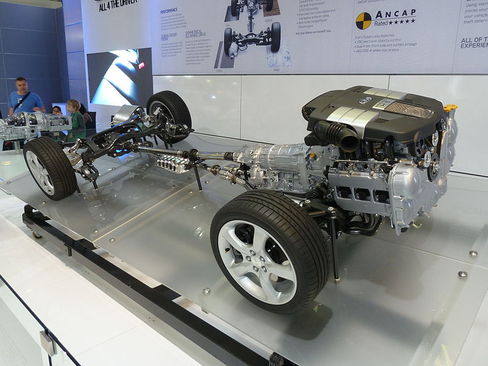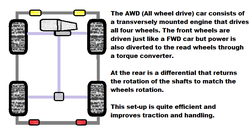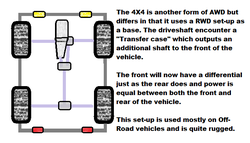Car Basics: What you need to know to make it all work
There are a few things you're just going to have to know
So cars are pretty complicated things, but when we strip them down to what you really need to know, they are actually quite simple. So let's start with some lingo:
(Remember that the care is essentially four components: The Body, the Frame, The Powertrain (or drivetrain), and the Interior.
(Remember that the care is essentially four components: The Body, the Frame, The Powertrain (or drivetrain), and the Interior.
Body and Chassis
These are both referred to as the "Frame" of the car and are what keep everything between the wheels in shape. You might here someone refer to a "Uni-Body" car; This is because some cars (usually pre-1980, or modern trucks for the most-part) have what's called a "Chassis." This is like a bedframe below a mattress, it's a rack of steel that the body sits on. A "Uni-Body" car, however, doesn't have this rack. Instead the body of the car, which is the panels and the roof and the fenders etc. actually bare the weight of the car themselves.
When we move on to the electrical, you'll know that the frame is also referred to as the "Ground" as it's always on the negative side of the battery. It's also important to note that in most cases the "body" is going to mean everything external to the car. So for example the body panels and trim are the doors and plastic bits. The bumpers and lighting on your care will usually be classified as "body" when it's not called the "electrical" and so on.
Drivetrain (or powertrain)
The drivetrain, or sometimes called powertrain (usually in the US), of a car is essentially everything mechanical that makes it go. The drivetrain consists of the engine, the transmission, the driveshafts and axles, the wheels and tires, the exhaust etc. Below if a photo of a drivetrain removed from a Toyota SUV :
Essentially, in most cases, what isn't the "Body" or the "Chassis" is going to either be the interior (self-explanatory) or the drive-train. These are the four basic elements of a car.
Drivetrains come in an assortment of shapes and sizes, but what you really need to know is this:
Drivetrains come in an assortment of shapes and sizes, but what you really need to know is this:
Click any of the above images to enlarge.
Once you understand the orientation of drivetrains you can focus on other aspects like the fuel and the size. These are also very simple:
Fuel:

Your car is likely going to be a Gasoline powered car. Most common cars are and the only thing to note here is that Gasoline comes in three varieties.
Regular: For most cars this will do.
Plus: This gasoline has a slightly elevated octane level. It burns slower and with more strength. Not many cars are tuned to it.
Premium: This gasoline has the highest octant level and burns slowest and with the most punch. Most high-end or high-performance cars will take this.
Diesel: This is a fuel usually used in large trucks, but also found in small European cars. (Mercedes, VWs, etc.) The pump should have a green handle and the nozzle will be larger so as to deter gasoline-car owners from accidentally filling with it.
Natural Gas and Propane: You may have noticed that some taxis and police cars smell a bit like french-fries. Well this is why. You'll definitely know if your car takes one of these are the filler will be completely different. Very unlikely to be mistaken.
Regular: For most cars this will do.
Plus: This gasoline has a slightly elevated octane level. It burns slower and with more strength. Not many cars are tuned to it.
Premium: This gasoline has the highest octant level and burns slowest and with the most punch. Most high-end or high-performance cars will take this.
Diesel: This is a fuel usually used in large trucks, but also found in small European cars. (Mercedes, VWs, etc.) The pump should have a green handle and the nozzle will be larger so as to deter gasoline-car owners from accidentally filling with it.
Natural Gas and Propane: You may have noticed that some taxis and police cars smell a bit like french-fries. Well this is why. You'll definitely know if your car takes one of these are the filler will be completely different. Very unlikely to be mistaken.
Check your owner's manual for what type of fuel you should be using. In the case of gasoline it will tell you which "Grade" to use.
You want to make sure to use the recommended fuel. Your car was engineered and tested on it; it may not run efficiently or at all if the wrong fuel is used.
You want to make sure to use the recommended fuel. Your car was engineered and tested on it; it may not run efficiently or at all if the wrong fuel is used.
Size:

Counting the sparkplug wires will indicate the number of cylinders.
When it comes to the engine size, there are quite a few variations. What you'll need to know for sure is:
-How many cylinders? Most cars today have 4 or 6.
As of 2011 the production cars on our roads come in 3,4,5,6,8,10,12, and 18 cylinders. From a Smart Car to a Bugatti Veyron. There's a good chance you'll have between 4 and 8 though. (In a pinch, count the sparkplug wires that go to the engine... there's 1 for every cylinder)
-How many liters? This is important when you are looking for engine parts. From air filters to oil filters to oils and coolants... it's important to know the engine size. Most engines will have a number in bold right on top. This, in Canada, is going to be the size in liters. You can also find this info in the owner's manual, and on any sticker that indicates the emissions systems.
The number will likely be between 1.5L and 5.5L, anything larger than this is likely a supercar or a very large truck. The average car will have a 2-2.5L engine.
(The size measures the volume of the engine cylinders in one full rotation. It's NOT a number indicating oil-volumes or anything else. See manual for these capacities)
-How many cylinders? Most cars today have 4 or 6.
As of 2011 the production cars on our roads come in 3,4,5,6,8,10,12, and 18 cylinders. From a Smart Car to a Bugatti Veyron. There's a good chance you'll have between 4 and 8 though. (In a pinch, count the sparkplug wires that go to the engine... there's 1 for every cylinder)
-How many liters? This is important when you are looking for engine parts. From air filters to oil filters to oils and coolants... it's important to know the engine size. Most engines will have a number in bold right on top. This, in Canada, is going to be the size in liters. You can also find this info in the owner's manual, and on any sticker that indicates the emissions systems.
The number will likely be between 1.5L and 5.5L, anything larger than this is likely a supercar or a very large truck. The average car will have a 2-2.5L engine.
(The size measures the volume of the engine cylinders in one full rotation. It's NOT a number indicating oil-volumes or anything else. See manual for these capacities)







